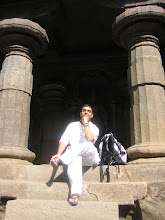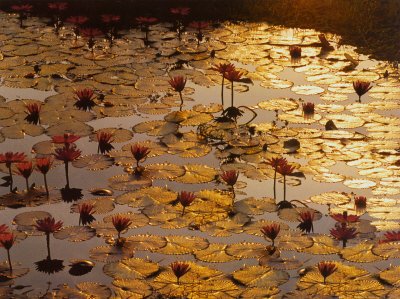...After resolving to delve into the Sutra, I began to plow through the Cleary translation. While I've been told it's not perfect (what translation is?) it is still a remarkable (1700 pages long!) and momentous achievement nonetheless. It just so happened that I started reading it as the summer break approached. Try as I might, I couldn't find a summer job but did manage to get a part-time volunteer position in a food pantry run by Saint Raymond's church up in The Bronx. Because I only worked a few hours a week, I had lots of time to read the sutra.
It is said of the great Indian epic, the Mahabharata "what can be found here may be found else where but what cannot be found here, cannot be found anywhere else"; in other words, it's supposed to cover EVERYTHING. In many ways, the Avataṃsaka is like that too. There are some parts of the text which are very straightforward and practical. The Pure Conduct chapter, for example, consists of replies in verse by the Bodhisattva Manjusri about a person who takes the Bodhisattva Vow. It's a "day in the life" type of narration as this person (he or she, the text is purposely ambiguous), wakes up and sees various things while traveling, and relates it all to Dharma practice. For example:
...When sitting in the full-lotus posture,
I vow that living beings
Will develop solid good roots,
and achieve the state of calm unmoving...
...While walking on a road,
I vow that livings beings
Will tread the Pure Dharma Realm,
With minds free and unobstructed...
...If I obtain delicious food,
I vow that livings beings
Will fulfill their aspirations,
And have no envy in their hearts...
...When I bathe my body,
I vow that livings beings
Will be unsullied in body and mind,
Radiant and clean, inside and out...
It is so because once Bodhisattvas attain the Ground of Happiness, theyWhat the sutra is most well known for and what caught my initial interest were the really far out out descriptions of reality; the interdependence and interpenetration of all phenomena are common themes of the Avataṃsaka. A good example can be found in Chapter 36, called "The Practice of Universal Good". Here, the Bodhisattva Samantabhadra describes some the penetrating insights of Awakening beings:
leave behind all fears; fears such as not staying alive,
fear of a bad reputation,
fear of death, fear of evil destinies,
fear of the virtue of the great assembly
They abandon all such fears forever. And why?
It is because these Bodhisattvas are free from the thought of a self. They do not cherish even their own bodies, how much less the wealth and possessions; therefore they have no fear of not staying alive.
They do not seek offerings from others but only give to other living beings; therefore, they have no fear of a bad reputation.
They have left the view of self far behind, and have no thought of self; therefore, they have no fear of death.
They themselves know that after death, they will certainly not be apart from the Buddhas and Bodhisattvas, therefore they have no fear of the evil destinies.
Their intent and and inclinations in all worlds are unequaled, how much the less surpassed; therefore they have no fear of the virtue of the great assembly.
Bodhisattvas, in that way, leave all alarming, hair raising, and terrifying experiences far behind.
...In every single atom
Are all things of all places and times;
The states and lands, innumerable,
The enlightening discern and know...
...They know the length and brevity of all ages,
And that past, present, and future are one moment:
The sameness and differences of myriad practices
They all distinctly know...
...All worlds
Enter one land:
The worlds do not become one,
Yet there is no mixup...
...They penetrate all worlds,
Vast and small,
One body countless lands,
One land, countless bodies...
...Innumerable lands
They cross over in an instant,
Yet through measureless eons
They don't move from their original place.
Untold eons
Are the space of a moment;
Not seeing long or short,
They find ultimate instantaneousness...
...The future is the past,
The present is the future,
The three times look to each other;
The enlightening understand each...
Thus in infinite ways;
They awaken the worlds:
No boundaries can be found
To the means of total knowledge.
One of (and perhaps) the most amazing and mind blowing things I've ever read occurs in the Gandavyuha (Entry Into the Conceivable). The plot of this chapter (often considered a sutra in its own right) revolves around a young spiritual pilgrim named Sudhana. Sudhana resolves to learn about the various practices of Awakened beings. Beginning with the Bodhisattva Manjushri, Sudhana travels from teacher to teacher (53 in all) and learns about dharma practices from a huge assortment of people; ascetics, mighty rulers, courtesans, celestials beings, bodhisattvas, and many more.
Towards the end of his quest, Sudhana encounters Maitreya Bodhisattva (teacher no. 50). In a beautiful exchange, Maitreya praises Sudhana welcomes him as a bodhisattva mahasattva to be. Maitreya then invites Sudhana to enter the Tower of Vairocana Buddha's Adornments. With a snap of his finger, Maitreya opens the door and Sudhana enters. What does Sudhana see inside?
He saw the tower immensely vast and wide, hundreds of thousands of leagues wide, as measureless as the sky, as vast as all of space, adorned with countless attributes; countless canopies, banners, pennants, jewels, garlands of pearls and gems, moons and half moons, multicolored streamers, jewel nets, gold nets, strings of jewels, jewels on golden threads, sweetly ringing bells and nets of chimes, flowers showering, celestial garlands and streamers, censers giving off fragrant fumes, showers of gold dust, networks of upper chambers, round windows, arches, turrets, mirrors, jewel figurines of women, jewel chips, pillars, clouds of precious cloths, jewel trees, jewel railings, jeweled pathways, jeweled awnings, various arrays of the floor, chambers of the jewels, jeweled promenades, rows of golden banana trees, statues made of all kinds of jewels, images of enlightening beings, singing birds, jewel lotuses, lotus ponds, jewel stairways, ground of masses of various jewels, radiant gems, arrays of all kinds of jewels. Also, inside the great tower he saw hundreds of thousands of other towers similarly arrayed; he saw those towers as infinitely vast as space, evenly arrayed in all directions, yet these towers were not mixed up with one another, being each mutually distinct, while appearing reflected in each and every object of the other towers.I don't know about you but I could use a breather after reading that.
Continuing on, Sudhana doesn't just see pretty buildings however. He also sees many other things inside of the tower (and towers inside his tower):
The moment he bowed, by the power of Maitreya, Sudhana perceived himself in all of those towers; and in all those towers he saw various diverse inconceivable miraculous scenes. In one tower he saw where the enlightening being Maitreya first aspired to supreme perfect enlightenment, what his family was, what his basic goodness was, how he was inspired, how he was encouraged by his spiritual friends, how long he lived, what age he lived in, what buddha he met, what land he adorned, what assembly he was in, and what kind of special vows he undertook. He also perceived the length of of life of the beings and the buddha of that time, and saw himself in the prescence of that buddha, and saw all of his works.Sudhana sees even more and more wondrous things with the descriptions more incredible and amazing than the above. The language and descriptions get progressively loftier and far out as Sudhana approaches the end of his quest (Manjushri and Samantabhadra are the 52nd and 53rd final teachers respectively).
As I stated before, such teachings just completely blow me away (in a good way!). Some of my good dharma friends that I've spoken to, however, have the opposite view: they feel such language is totally excessive, ridiculous and pointless, i.e. not relevant to "real practice". I'll argue, however, that the very far out language of the sutra is an excellent tool to help our practice.
The purpose of such amazing and wondrous descriptions of reality and phenomena have a very specific purpose: to take all of our imaginations, conceptions, and ideas and stretch them to the limit, thus setting the stage for us to go beyond all of these things. As Ajahn Amaro of Abhayagiri Monastery likes to say, "we can't think our way out of samsara".
Reflecting on ideas such as the vastness of the universe (or multiverses), how they intersect, interpenetrate, and are interconnected in a net of phenomena and causality is useful for another reason: it helps break down the idea of the Self. I, for one, find it much harder to hold up my own tiny slice of the world as all important when confronted with the awesome expanse of reality as presented in the Avataṃsaka.
As amazing and inspiring as I find the sutra, I also find some (actually a lot) very difficult to understand. Despite this, I can't help the feeling that even if many of the teachings are currently "over my head" I know that they come from a special place: the minds of Awakened Beings. What I actually do understand has totally transformed the way I view my practice and understanding of the Buddha Dharma.
A discussion I had with one of the monks at the Berkeley Buddhist Monastery (which hosts and webcasts Avataṃsaka lectures every Saturday night) shed much light on how I view the sutra. After expressing my feelings on the text (almost verbatim from the previous paragraph) the Ven. Chin He said to me, "Well you have to understand, you pick up the sutra, open the pages, and read from one cover to the next, in a straight line. What the sutra teaches, however, is not a straight line. It is like a three dimensional sphere that pervades everything. Actually infinite dimensions if we look at the Avataṃsaka itself haha". I couldn't agree more.
Ultimately though, beyond the amazing descriptions and profound imagery, the sutra deals with the foundation of the Mahayana teachings: the Bodhisattva Path. In describing this Path, the sutra manages to yet again blow us away with its profound eloquence:
It is like a great regal tree growing in the rocks and sand of a
barren wilderness. When the roots get water, the branches, leaves,
flowers, and fruits will all flourish. The regal Bodhi-tree growing in
the wilderness of birth and death is the same. All living beings are
its roots; all Buddha’s and Bodhisattvas are its flowers and fruits.
By benefiting all beings with the water of great compassion, one can
realize the flowers and fruits of the Buddha’s and Bodhisattvas
wisdom. Why is this? It is because by benefiting living beings with
the water of great compassion, the Bodhisattvas can achieve supreme
perfect enlightenment; therefore, Bodhi belongs to living beings.
Without living beings, no Bodhisattva could achieve supreme, perfect
enlightenment.








No comments:
Post a Comment